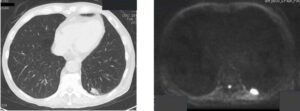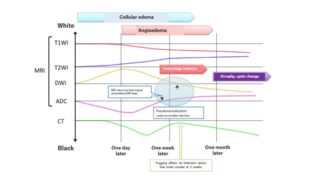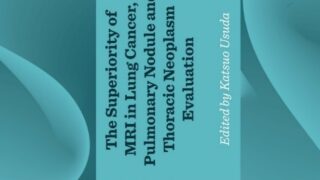A new examination without radiation exposure: DWIBS
I share a passionate desire with many people to restore the Soso region of Fukushima Prefecture in Japan. I would like to help in whatever way I can. Diffusion-weighted MRI images are not only useful for early diagnosis of cerebral infarction, but also for diagnosing malignant tumors in the chest, abdomen, breast, gynecological, and urological regions, and can also diagnose distant metastases, including bone metastases. MRI is extremely useful for distinguishing benign from malignant tumors, searching for distant metastases, and searching for abscesses, as there is no radiation exposure.
 Figure: CT images and MRI diffusion-weighted images of lung cancer
Figure: CT images and MRI diffusion-weighted images of lung cancer
DWIBS (Diffusion-weighted whole-body imaging with background suppression), an MRI examination that searches for cancer lesions throughout the body in a single test, can detect cancer lesions in the same way as PET-CT, and cancer lesions are easy to recognize because they glow white. I believe it will also be useful in health checkups for residents of the Soso region who are allergic to radiation exposure. In a word, DWIBS can be said to be an inexpensive PET-CT without the radiation. PET-CT and DWIBS have almost the same results, and in some cases DWIBS outperforms PET-CT, and in other cases PET-CT outperforms DWIBS. Malignant tumors that can be easily detected with DWIBS include lung cancer, breast cancer, colon cancer, urological cancer, and gynecological cancer, but gastric cancer is difficult to detect when there is inflammation. According to Dr. Yuzo Shimoide of the Department of Head and Neck Surgery at Kanazawa Medical University, thyroid cancer may also be detected.
We hope that DWIBS will be used in the health checkups of residents in the Soso area of Fukushima Prefecture, who are allergic to radiation exposure. With the low cost and no radiation we feel DWIBS can offer greater care for a wider range of patients that are in need.
Yuzo Shimoide, et al.: “Usefulness of multimodality evaluation in thyroid follicular lesions” Head and Neck Cancer 46 (1): 52—58, 2020.
https://www.jstage.jst.go.jp/article/jjhnc/46/1/46_52/_pdf









